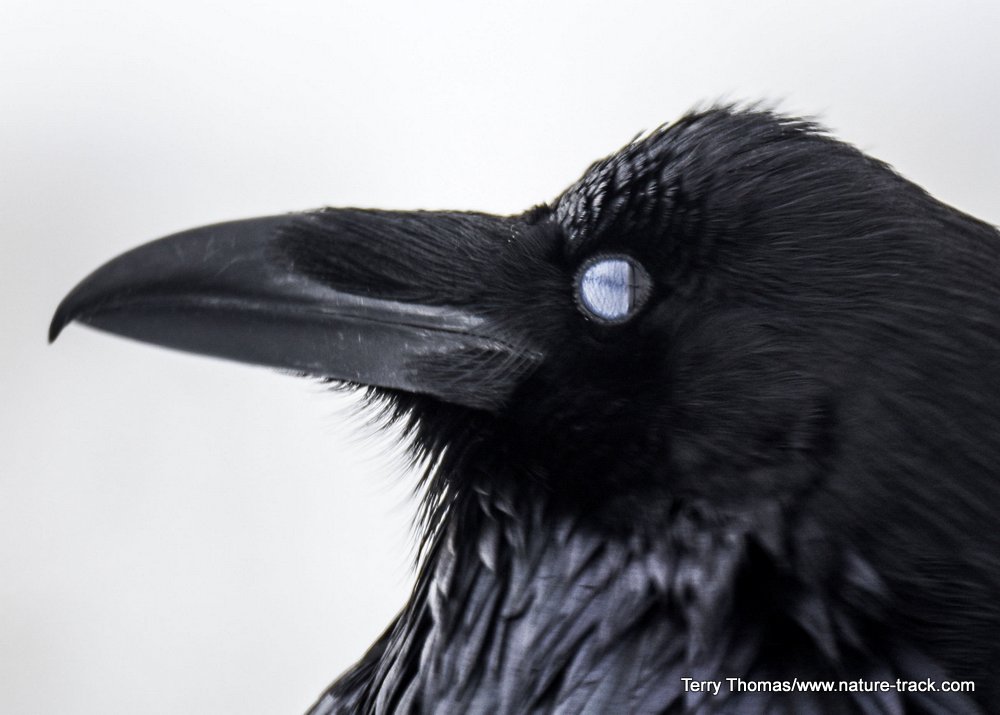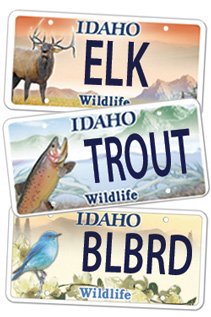Nictitating Membrane Saves Eyes

This raven shows a nictitating membrane that is mostly closed.
The dang nail, driven deep into a concrete wall, just wouldn’t come out. With youthful exuberance, I worked at it, bending it one way, then the other, hoping to fatigue the high strength steel. I succeeded far better than I hoped and with a snap, the nail broke at the edge of the concrete and like a projectile from a Red Rider BB gun, shot straight for my right eye. Fortunately, my eyeglasses, something I have cussed since Kindergarten, absorbed the blow. The nail left a huge nick dead center in the glass, but my eye was safe. Grateful not to have lost an eye, I stopped complaining about wearing glasses after that.
There are few species for which vision is not essential for survival. Some bats, moles, cave dwellers and humans are exceptions, but the rule still holds for the vast majority of species—lose your eyes, lose your life.
With something so critical, it seems reasonable to assume that nature has provided something like my eyeglasses to help animals protect their eyes from environmental hazards. Sure, most of us have eyelids, but when they are closed, vision ceases. A prizefighter will tell you that you will win few fights with your eyes closed, so that isn’t a great option.
Fortunately, many species have developed a nictitating membrane, what is often referred to as a third eyelid, that lays underneath the upper and lower eyelids. Unlike the upper and lower eyelids, this nictitating (which means blinking) membrane moves horizontally, not up and down, from the inner corner to the outer corner of the eye.
The nictitating membrane offers protection when the animal still needs to see because it is translucent, though not always totally clear. Birds can actively initiate the nictitating membrane. Thus, when a peregrine falcon dives for prey at 150 miles an hour, it can watch its prey, time its approach and still keep its eyes clear and moistened. When a bald eagle brings back dinner to a nest full of hungry chicks, the nictitating membrane helps protect the parent from the overly exuberant and hungry nestlings. When a black-capped chickadee dives for thick cover at the approach of a Cooper’s hawk, the nictitating membrane activates to protect its eyes.
It is surprising how many species have a nictitating membrane. Most all birds have one. Many reptiles, amphibians and fish have a nictitating membrane and even some mammals do. Polar bears, seals and beaver are just a few of the mammals with nictitating membranes and it is easy to imagine how such goggle-like protection would be important to these swimming mammals. For arctic animals, the membrane may also act as a shield against the intense glare of sun on snow, preventing snow blindness.
Humans, and really most primates, are not lucky enough to have a nictitating membrane although people have a vestigial (remnant) nictitating membrane, the plica semilunaris of conjunctiva.
It isn’t easy to see the nictitating membrane in motion unless you observe very closely. When photographing birds though, it isn’t uncommon to catch the nictitating membrane in some stage of actuation, especially when shooting at eight frames per second.
Although humans don’t have a nictitating membrane, we can take steps to protect our eyes. Protective lenses, often called safety glasses, can save our eyesight and like the birds, we can choose whether or not to use them.
Help Idaho Wildlife
When we traveled across the state in October 2017, we visited most of the Idaho Department of Fish and Game wildlife management areas. Most of the vehicles we saw using the wildlife management areas did not have wildlife plates. Buying wildlife plates is a great way for non-hunters and hunters alike to support wildlife-based recreation like birding.
C'mon folks, let's help Idaho's wildlife by proudly buying and displaying a wildlife license plate on each of our vehicles!
See below for information on Idaho plates. Most states have wildlife plates so if you live outside Idaho, check with your state's wildlife department or vehicle licensing division for availability of state wildlife plates where you live.
And tell them that you heard about it from Nature-track.com!

Wildlife License Plates
Great news! as of 2024, there are three NEW designs for license plates. They still are bluebird, cutthroat trout and elk, but they are beautiful.
Idaho Wildlife license plates provide essential funding that benefits the great diversity of native plants and wildlife that are not hunted, fished or trapped—over 10,000 species or 98% of Idaho’s species diversity. Game species that share the same habitats (such as elk, deer, antelope, sage-grouse, salmon, trout) also benefit from these specialty plates.
No state tax dollars are provided for wildlife diversity, conservation education and recreation programs. Neither are any revenues from the sale of hunting or fishing licenses spent on nongame species. Instead, these species depend on direct donations, federal grants, fundraising initiatives—and the Idaho Wildlife license plates.
Both my vehicles have Bluebird Plates. I prefer the bluebird because the nongame program gets 70 percent of the money from bluebird plates, but only 60 percent of the money from elk and trout plates - 10 percent of the money from elk plates supports wildlife disease monitoring and testing programs (to benefit the livestock industry) and 10 percent from cutthroat plates supports non-motorized boat access.
Incidentally, in 2014, the Idaho Legislature denied the Department of Fish and Game the ability to add new plates or even to change the name of the elk and cutthroat plates (very specific) to wildlife and fish plates, a move that would have allowed for changing images occasionally and generating more revenue. It would seem that they believe that we Idahoans don't want a well funded wildlife program.
I think it is time we let the Legislature know that Idahoan support wildlife funding and that we would like to see these generic plates come to fruition.

"WOW. What a phenomenal piece you wrote. You are amazing." Jennifer Jackson
That is embarrassing, but actually a fairly typical response to my nature essays. Since The Best of Nature is created from the very best of 16 years of these nature essays published weekly in the Idaho Falls Post Register (online readership 70,000), it is a fine read. It covers a wide variety of topics including humorous glimpses of nature, philosophy, natural history, and conservation. Readers praise the style, breadth of subject matter and my ability to communicate complex and emotional topics in a relaxed and understandable manner.
Everyone can find something to love in this book. From teenagers to octogenarians, from the coffee shop to the school room, these nature essays are widely read and enjoyed.
Some of the essays here are my personal favorites, others seemed to strike a chord with readers. Most have an important message or lesson that will resonate with you. They are written with a goal to simultaneously entertain and educate about the wonderful workings of nature. Some will make you laugh out loud and others will bring a tear to the eye and warm your heart.
Readers Write:
"You hit a home run with your article on, Big Questions in Nature. It should be required reading for everyone who has lost touch with nature...great job!" Joe Chapman
"We enjoyed your column, Bloom Where Planted. Some of the best writing yet. The Post Register is fortunate to have your weekly columns." Lou Griffin.
To read more and to order a copy, click here or get the Kindle version
Copies are also available at:
Post Register
Island Park Builders Supply (upstairs)
Barnes and Noble in Idaho Falls
Harriman State Park, Island Park
Museum of Idaho
Valley Books, Jackson Wyoming
Avocet Corner Bookstore, Bear River National Wildlife Refuge, Brigham City, Utah
Craters of the Moon National Monument Bookstore, Arco, Idaho
Wildlife License Plates
Great news! as of 2024, there are three NEW designs for license plates. They still are bluebird, cutthroat trout and elk, but they are beautiful.
Idaho Wildlife license plates provide essential funding that benefits the great diversity of native plants and wildlife that are not hunted, fished or trapped—over 10,000 species or 98% of Idaho’s species diversity. Game species that share the same habitats (such as elk, deer, antelope, sage-grouse, salmon, trout) also benefit from these specialty plates.
No state tax dollars are provided for wildlife diversity, conservation education and recreation programs. Neither are any revenues from the sale of hunting or fishing licenses spent on nongame species. Instead, these species depend on direct donations, federal grants, fundraising initiatives—and the Idaho Wildlife license plates.
Both my vehicles have Bluebird Plates. I prefer the bluebird because the nongame program gets 70 percent of the money from bluebird plates, but only 60 percent of the money from elk and trout plates - 10 percent of the money from elk plates supports wildlife disease monitoring and testing programs (to benefit the livestock industry) and 10 percent from cutthroat plates supports non-motorized boat access.
Incidentally, in 2014, the Idaho Legislature denied the Department of Fish and Game the ability to add new plates or even to change the name of the elk and cutthroat plates (very specific) to wildlife and fish plates, a move that would have allowed for changing images occasionally and generating more revenue. It would seem that they believe that we Idahoans don't want a well funded wildlife program.
I think it is time we let the Legislature know that Idahoan support wildlife funding and that we would like to see these generic plates come to fruition.